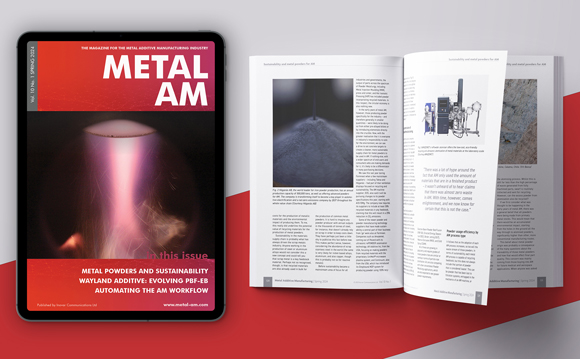Machine learning algorithm designs new alloy for metal Additive Manufacturing
April 29, 2019
A new machine learning algorithm developed by Intellegens, an artificial intelligence company based in Cambridge, UK, has been used to design a new nickel-based alloy for metal Additive Manufacturing, in a research collaboration between a number of commercial partners and the University of Cambridge’s Stone Group. According to Intellegens, the use of the algorithm saved the team an estimated fifteen years of materials research and around $10 million in R&D costs.
The Alchemite™ deep learning algorithm was used to design the new alloy, intended for processing by Directed Energy Deposition (DED), by analysing existing materials information to identify a new nickel-based combustor alloy that could satisfy the performance targets needed to additively manufacture a component for application in a jet engine.
The development of new materials using conventional research techniques remains a lengthy and expensive process that typically involves a considerable degree of trial and error – and designing new alloys for DED is said to be particularly challenging. To date, DED has only been applied to around ten nickel-alloy compositions, which severely restricted the amount of data available to motivate further investigations.
Alchemite was said to have offered the alloy research team a way around this lack of data and a means of speeding up the overall material selection process. Capable of learning from data that is as little as 0.05% complete, Alchemite was able to link and cross-reference the data available; verify the physical properties of potential new alloys; and accurately predict how they would function in real-life application scenarios.
Following the application of Alchemite, and the identification of the most suitable alloy option, the research team led by the Stone Group embarked on a round of experiments to confirm the new material’s physical properties. The characteristics that the team wanted the new alloy to possess spanned processability, cost, density, phase stability, creep resistance, oxidation, fatigue life and resistance to thermal stresses. Results showed that the new alloy was better suited to DED and the application in question than other commercial alloys available.
Gareth Conduit, Chief Technology Officer at Intellegens, and a Royal Society University Research Fellow at the University of Cambridge, explained, “With deep learning capabilities that can pinpoint property-to-property relationships very quickly, Alchemite was uniquely positioned to assist with this project. Using machine learning, Alchemite enabled the team to use a large database of thermal resistance measurements to guide the extrapolation of just ten data entries of alloy processability.”
“From that information we were able to shortlist material combinations that were most likely to deliver the right characteristics. The results speak for themselves. Thanks to Alchemite, the team now has a new alloy at its disposal and has saved vast amounts of time and money on R&D,” he continued.
“Worldwide there are millions of materials available commercially that are characterised by hundreds of different properties. Using traditional techniques to explore the information we know about these materials, to come up with new substances, substrates and systems, is a painstaking process that can take months if not years. Learning the underlying correlations in existing materials data, to estimate missing properties, the Alchemite engine can quickly, efficiently and accurately propose new materials with target properties – speeding up the development process.”
















